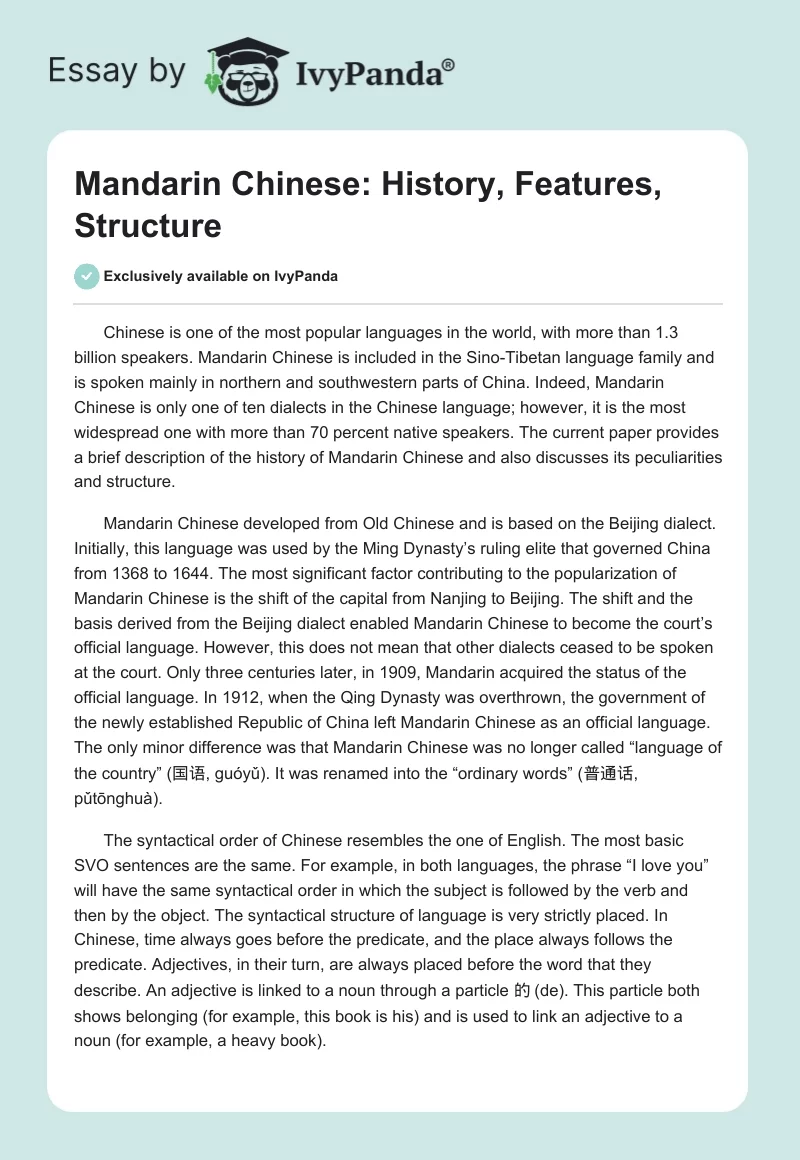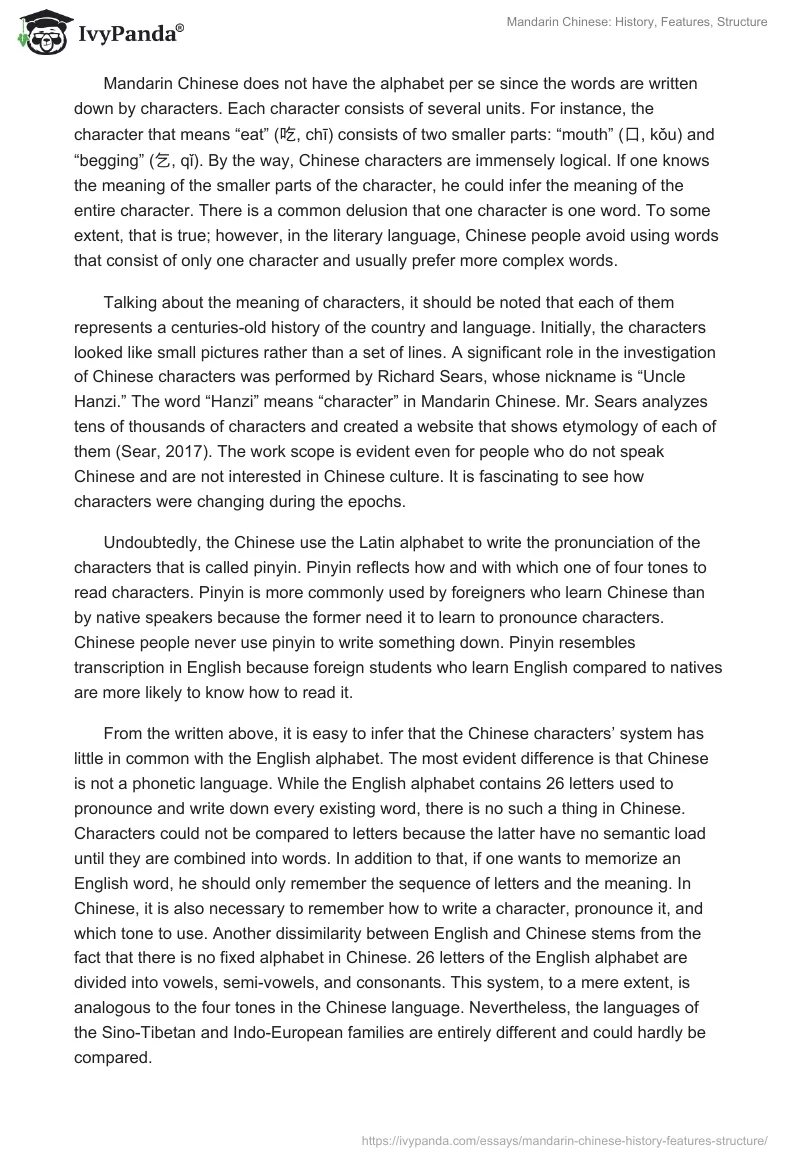Chinese is one of the most popular languages in the world, with more than 1.3 billion speakers. Mandarin Chinese is included in the Sino-Tibetan language family and is spoken mainly in northern and southwestern parts of China. Indeed, Mandarin Chinese is only one of ten dialects in the Chinese language; however, it is the most widespread one with more than 70 percent native speakers. The current paper provides a brief description of the history of Mandarin Chinese and also discusses its peculiarities and structure.
Mandarin Chinese developed from Old Chinese and is based on the Beijing dialect. Initially, this language was used by the Ming Dynasty’s ruling elite that governed China from 1368 to 1644. The most significant factor contributing to the popularization of Mandarin Chinese is the shift of the capital from Nanjing to Beijing. The shift and the basis derived from the Beijing dialect enabled Mandarin Chinese to become the court’s official language. However, this does not mean that other dialects ceased to be spoken at the court. Only three centuries later, in 1909, Mandarin acquired the status of the official language. In 1912, when the Qing Dynasty was overthrown, the government of the newly established Republic of China left Mandarin Chinese as an official language. The only minor difference was that Mandarin Chinese was no longer called “language of the country” (国语, guóyǔ). It was renamed into the “ordinary words” (普通话, pǔtōnghuà).
The syntactical order of Chinese resembles the one of English. The most basic SVO sentences are the same. For example, in both languages, the phrase “I love you” will have the same syntactical order in which the subject is followed by the verb and then by the object. The syntactical structure of language is very strictly placed. In Chinese, time always goes before the predicate, and the place always follows the predicate. Adjectives, in their turn, are always placed before the word that they describe. An adjective is linked to a noun through a particle 的 (de). This particle both shows belonging (for example, this book is his) and is used to link an adjective to a noun (for example, a heavy book).
Mandarin Chinese does not have the alphabet per se since the words are written down by characters. Each character consists of several units. For instance, the character that means “eat” (吃, chī) consists of two smaller parts: “mouth” (口, kǒu) and “begging” (乞, qǐ). By the way, Chinese characters are immensely logical. If one knows the meaning of the smaller parts of the character, he could infer the meaning of the entire character. There is a common delusion that one character is one word. To some extent, that is true; however, in the literary language, Chinese people avoid using words that consist of only one character and usually prefer more complex words.
Talking about the meaning of characters, it should be noted that each of them represents a centuries-old history of the country and language. Initially, the characters looked like small pictures rather than a set of lines. A significant role in the investigation of Chinese characters was performed by Richard Sears, whose nickname is “Uncle Hanzi.” The word “Hanzi” means “character” in Mandarin Chinese. Mr. Sears analyzes tens of thousands of characters and created a website that shows etymology of each of them (Sear, 2017). The work scope is evident even for people who do not speak Chinese and are not interested in Chinese culture. It is fascinating to see how characters were changing during the epochs.
Undoubtedly, the Chinese use the Latin alphabet to write the pronunciation of the characters that is called pinyin. Pinyin reflects how and with which one of four tones to read characters. Pinyin is more commonly used by foreigners who learn Chinese than by native speakers because the former need it to learn to pronounce characters. Chinese people never use pinyin to write something down. Pinyin resembles transcription in English because foreign students who learn English compared to natives are more likely to know how to read it.
From the written above, it is easy to infer that the Chinese characters’ system has little in common with the English alphabet. The most evident difference is that Chinese is not a phonetic language. While the English alphabet contains 26 letters used to pronounce and write down every existing word, there is no such a thing in Chinese. Characters could not be compared to letters because the latter have no semantic load until they are combined into words. In addition to that, if one wants to memorize an English word, he should only remember the sequence of letters and the meaning. In Chinese, it is also necessary to remember how to write a character, pronounce it, and which tone to use. Another dissimilarity between English and Chinese stems from the fact that there is no fixed alphabet in Chinese. 26 letters of the English alphabet are divided into vowels, semi-vowels, and consonants. This system, to a mere extent, is analogous to the four tones in the Chinese language. Nevertheless, the languages of the Sino-Tibetan and Indo-European families are entirely different and could hardly be compared.
Reference
Sears, R. (2017). Chinese Etymology 字源. Web.


